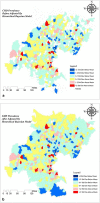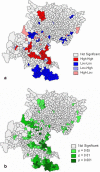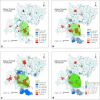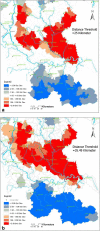Spatial patterns of the congenital heart disease prevalence among 0- to 14-year-old children in Sichuan Basin, P. R China, from 2004 to 2009
- PMID: 24924350
- PMCID: PMC4073187
- DOI: 10.1186/1471-2458-14-595
Spatial patterns of the congenital heart disease prevalence among 0- to 14-year-old children in Sichuan Basin, P. R China, from 2004 to 2009
Abstract
Background: Congenital heart disease (CHD) is the most common type of major birth defects in Sichuan, the most populous province in China. The detailed etiology of CHD is unknown but some environmental factors are suspected as the cause of this disease. However, the geographical variations in CHD prevalence would be highly valuable in providing a clue on the role of the environment in CHD etiology. Here, we investigate the spatial patterns and geographic differences in CHD prevalence among 0- to 14-year-old children, discuss the possible environmental risk factors that might be associated with CHD prevalence in Sichuan Basin from 2004 to 2009.
Methods: The hierarchical Bayesian model was used to estimate CHD prevalence at the township level. Spatial autocorrelation statistics were performed, and a hot-spot analysis with different distance thresholds was used to identify the spatial pattern of CHD prevalence. Distribution and clustering maps were drawn using geographic information system tools.
Results: CHD prevalence was significantly clustered in Sichuan Basin in different spatial scale. Typical hot/cold clusters were identified, and possible CHD causes were discussed. The association between selected hypothetical environmental factors of maternal exposure and CHD prevalence was evaluated.
Conclusions: The largest hot-spot clustering phenomena and the CHD prevalence clustering trend among 0- to 14-year-old children in the study area showed a plausibly close similarity with those observed in the Tuojiang River Basin. The high ecological risk of heavy metal(Cd, As, and Pb)sediments in the middle and lower streams of the Tuojiang River watershed and ammonia-nitrogen pollution may have contribution to the high prevalence of CHD in this area.
Figures






References
-
- Liu YL. The advancement and challenges of management of infant and young children's congenital heart defect in China. Nat Med J China. 2004;84(11):881–884. - PubMed
-
- Ouyang N, Luo J, Du Q, Liu Z. Case–control study on environmental factors in congenital heart disease. J Cent S Univ Med Sci. 2011;36(2):159–164. - PubMed
Publication types
MeSH terms
LinkOut - more resources
Full Text Sources
Other Literature Sources
Medical
Research Materials

